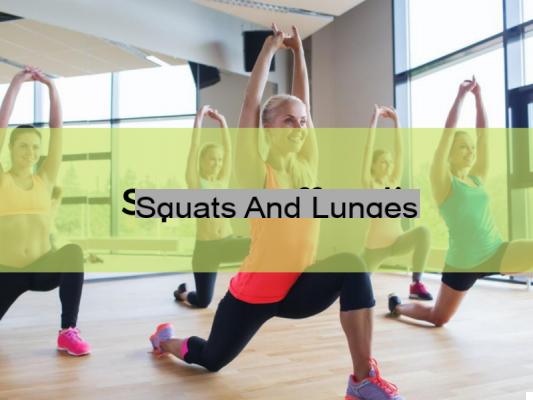
When train la lower body, the first choice almost always falls on squatting.
This very common exercise is absolutely functional for the toning of buttocks and leg muscles but it is not the only one.
Even the lungesIn fact, carry out admirably this task, sculpting the legs even better than squats.
Working on one leg at a time, in fact, lunges offer a series of additional benefits such as improving balance and strengthening the core.
Both exercises are perfect if you start exercising again after a period of inactivity.
How Many Squats?
If the squatting it is one of the most popular exercises, the reasons are different, first of all the fact that supports very well i daily movements (just think about how many times you squat to pick something up from the ground), strengthening tendons e ligaments.
But as with all exercises, although excellent, DON'T it means you have to exaggerate with the sessions, in order to avoid excessive development of the muscles of the anterior part of the thighs.
Train at your best i quadriceps it is certainly important, but too much force concentrated in that point can generate one muscle imbalance if you do not pay attention to the buttocks and hamstrings as well. As a result, this can lead to you becoming more prone to lower back, hip or knee pain.
Squats are also very useful for and strengthening the hip.
While being careful, if you want to intensify your training there are mobility exercises to make the squats deeper.
Squats are considered isotonic exercises, which differ from isometrics.
The importance of the technique
Also doing them incorrectly it can be counterproductive and lead to the same result.
Do the squatting holding your knees at an angle greater than 90 degrees or lifting too heavy a weight, for example, can cause one stress excessive on the lower back and in the long run also lead to injury, according to the American College of Sports Medicine.
How many lunges?
Restrict squatting in favor of some lunge plus it is therefore an excellent idea.
- lunges they are a simple and functional exercise and guarantee a series of benefits that are impossible to obtain from traditional squats.
For one thing, it has been shown that those forward they work the buttocks (especially the gluteus maximus and middle) and hamstrings more effectively than bodyweight squats. This helps balance the muscle fascia along the front and back of the legs.
Lunges are also more functional than many other lower body exercises, as they involve forward motion. By mimicking the human walking pattern, they can encourage correct gait and posture.
Work on balance
It should also not be forgotten that, unlike squats, the lunges are a unilateral exercise, a feature that helps address muscle imbalances on the left and right sides of the body. Although such imbalances do not directly cause injury, they can still lead to improper movement during training and to one incorrect posture.
Since they keep one leg busy at a time, the typical lunge moves allow you to focus on each side of the body in a specific way, without letting the dominant half of each take over, as can happen with exercises that train both at the same time. Over time, this feature helps to correct any pre-existing imbalances, while also preventing future asymmetries.
- lunges they are also an excellent exercise building balance. Standing on one side as you shift your weight back and forth activates the body's small stabilizing muscles, which are crucial for overall balance and coordination.
Exercises
To make your legs stronger, it is therefore advisable to insert some kind of lunge in its own training circuit, perhaps replacing it with a couple of sets of squatting.
These two variants are among the most effective.
Lunges with dumbbells
- Stand upright, holding a dumbbell in each hand. The arms can be extended at the sides or raised to shoulder height.
- Take a few steps forward with your left foot.
- Lower yourself into a lunge until both knees are bent 90 degrees. The rear knee should stop just above the ground and the front knee should be perpendicular to the ankle.
- Hold the position for a second before pushing your front foot back to standing.
- Repeat the sequence with the other leg.
Reverse lunges with dumbbells
L'previous year, pushing the body forward, it can be tiresome to be carried out for people with sensitive or sore knees. For those suffering from these problems, reverse lunges are a safer alternative, which still offers many benefits.
- Begin from the standing position, holding a dumbbell in each hand. The arms can be extended at the sides or raised to shoulder height.
- Bring the left foot back a few meters, keeping the right foot firmly on the ground.
- Lower yourself into a lunge until both knees are bent 90 degrees. The left knee should stop just before the ground, while the right knee should be perpendicular to the ankle.
- Hold the position for a second, then push through the right foot to return to standing.
- Repeat the movement on the other side.
To train the legs, the stability ball is also useful for a complete workout.
Alternatively, shrimp squats can be performed.
Exercises to "stretch" the legs are also excellent.
These exercises can contribute to training for neglected muscles.


























